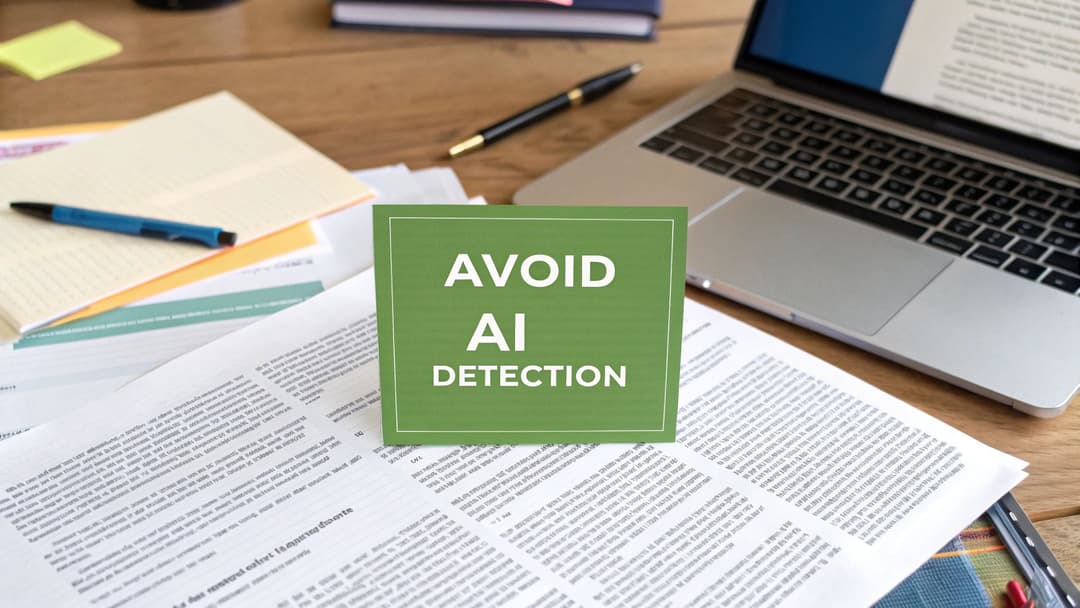
How to Develop a Content Strategy That Gets Results
August 25, 2025
Before you write a single word or film a single frame, your content strategy needs a solid foundation. This isn't the time to brainstorm blog titles. This is about building the strategic compass that will guide every decision you make from here on out.
Think of it like building a house. You wouldn’t start ordering furniture before you have the blueprints, right? In the same way, you can't create effective content until you define what "effective" even means for your business and who you're trying to reach. Without this groundwork, you’re just creating a series of disconnected assets, not a cohesive plan built for impact.
First, What Are Your Business Objectives?
Your content doesn't exist in a vacuum. Every article, video, and social post needs to pull its weight by directly supporting a larger business objective. The first question you have to answer is: what do we want our content to achieve?
Common goals usually fall into a few buckets:
- Growing brand awareness: Getting your name in front of more of the right people.
- Generating qualified leads: Attracting potential customers who are a great fit for what you sell.
- Improving customer retention: Giving current customers so much value they never want to leave.
- Establishing industry authority: Becoming the go-to resource in your niche.
But vague goals like "get more traffic" won't cut it. You need clarity. A framework like SMART (Specific, Measurable, Achievable, Relevant, Time-bound) is your best friend here. For example, a much better goal is: "Increase organic blog traffic from marketing managers by 25% in the next quarter by publishing four in-depth articles targeting their key pain points." Now that's a target your team can actually aim for.

As you can see, without clear objectives, any subsequent planning is just guesswork.
Get Inside Your Audience's Head
Once you know why you're creating content, you need to figure out who you're creating it for. This goes so much deeper than basic demographics like age and location. Real audience understanding comes from digging into their psychographics—their challenges, their motivations, what keeps them up at night, and what they're trying to accomplish.
The most successful content strategies I've seen are built on an almost obsessive understanding of the target audience. You need to know their problems better than they do and provide the solutions before they even know what to search for.
How do you get this information? You talk to people.
- Interview your best customers: Ask them about their biggest challenges and how they found you in the first place.
- Survey your email list: Use simple tools to gather insights at scale.
- Be a fly on the wall: Platforms like Reddit or niche industry forums are goldmines of raw, unfiltered customer language.
- Talk to your sales and support teams: They're on the front lines every single day, hearing customer questions and objections firsthand.
Your end goal here is to build a detailed buyer persona—a semi-fictional profile of your ideal customer. Give them a name, a job title, and a list of their daily frustrations. This persona becomes your North Star, ensuring you’re always writing for a real person, not a faceless demographic. For a deeper dive, this comprehensive content marketing strategy guide is a fantastic resource.
Define Your Core Message and Voice
Finally, what makes you different? Your competitors are probably targeting a similar audience with similar goals. Your core message is your unique value proposition—the specific angle, expertise, or solution that only you can provide.
Your brand voice is simply how that message comes to life. Are you authoritative and academic? Conversational and witty? A little bit snarky? Documenting your tone and style ensures consistency, whether you're a one-person show or have a whole team of creators. This is a critical piece of a wider digital marketing content strategy.
It's no surprise that developing a documented strategy has become standard practice; 90% of organizations now have one. Success, however, is most strongly tied to deep audience research and SEO—elements that nearly half of all businesses consider essential.
To wrap up this initial phase, let's look at the core components you need to lock down before moving on.
Core Components of a Content Strategy Foundation
This table sums up the essential building blocks for a strategy that actually works. Getting these right from the start saves a massive amount of time and resources down the road.
| Component | What to Define | Why It Matters |
|---|---|---|
| Business Goals | Specific, measurable outcomes you want to achieve (e.g., lead generation, awareness). | Ensures your content directly contributes to business growth and isn't just noise. |
| Target Audience | Detailed buyer personas, including pain points, motivations, and questions. | Allows you to create content that deeply resonates and solves real problems. |
| Core Message | Your unique value proposition and the central idea behind all your content. | Differentiates you from competitors and creates a memorable brand identity. |
| Brand Voice & Tone | The personality of your content (e.g., expert, friendly, witty, formal). | Builds a consistent and recognizable brand experience across all channels. |
Nailing these four elements gives you a strong, strategic foundation to build upon. With this clarity, every piece of content you create will have a clear purpose and a much higher chance of success.
Planning Your Content and Choosing Your Channels
Alright, you’ve got the strategic foundation down. Now it’s time to move from the “why” to the “what” and “where.” This is the fun part—mapping out the actual content you’ll create and deciding where it’s all going to live.
Good planning makes sure every blog post, video, or social update has a clear purpose and a designated home.
The goal isn't to be everywhere at once. It's to be exactly where your audience hangs out, with content that hits them right when they need it. This means getting specific about the topics you’ll cover and the platforms you'll use to share them.
Brainstorming Content That Solves Problems
Your audience research is basically a cheat sheet for brainstorming. Instead of throwing darts at a wall and hoping a topic sticks, you can pull ideas directly from the pain points and questions you’ve already uncovered.
Think about the entire journey someone takes before they become a customer.
What questions pop into their head when they first realize they have a problem (Awareness)? What are they looking for when they start comparing solutions (Consideration)? And what final bit of info pushes them to make a choice (Decision)?
- Awareness Stage: The content here needs to be helpful and educational, not a sales pitch. Think "how-to" guides, checklists, or simple videos that address a high-level problem. For a software company, this might be an article like, "5 Signs Your Team’s Project Management Is Broken."
- Consideration Stage: Okay, now you can start introducing your solution more directly. This is where you bring in product comparisons, case studies showing off customer wins, or detailed webinars that walk through your features.
- Decision Stage: This is all about sealing the deal. Content here could be a free trial, a step-by-step implementation guide, or a detailed pricing page that answers those last-minute questions.
This approach creates a smooth path that guides people from one stage to the next without feeling forced.
Building Topic Clusters for Authority
A really effective way to organize your ideas and give your SEO a serious boost is to use topic clusters. The model is simple: you create one massive, in-depth piece of content on a broad subject—this is your pillar page. Then, you write several related articles on more specific subtopics that all link back to that main pillar.
For example, your pillar page might be "The Ultimate Guide to Remote Team Collaboration." Your cluster content would then be smaller, focused articles like "The 10 Best Tools for Remote Teams," "How to Run Virtual Meetings That Don't Suck," and "A Guide to Asynchronous Communication."
This structure does wonders for search engines. It signals that you’re an authority on the whole topic, which helps you rank for a ton of related keywords.
Selecting the Right Channels and Formats
So, where does all this amazing content actually go? The answer is simple: wherever your audience is. Don't waste your budget building a huge TikTok presence if your C-suite audience spends all their time on LinkedIn and in industry newsletters.
Your channel strategy should be audience-led, not trend-led. It’s way better to dominate a few relevant channels with great content than to spread yourself thin across every platform out there.
Start by picking your primary channel. This is usually a blog or a YouTube channel—something you own and control. This will be the home base for your most important, long-lasting content. From there, pick a couple of social channels to chop up and distribute that content.
Choosing the right format is just as critical. Long-form blog posts are an SEO goldmine, but they aren’t your only option. The game is always changing. For instance, video content, especially short-form stuff on platforms like TikTok and Instagram, is seeing huge engagement right now. This shift means marketers need to think more dynamically. You can actually discover insights on content marketing statistics that back this up.
Here’s a quick look at some popular formats and what they’re good for:
| Content Format | Best For | Key Benefit |
|---|---|---|
| Blog Posts | In-depth education, SEO, building authority | Drives long-term organic traffic and trust. |
| Short-Form Video | Brand personality, quick tips, engagement | Highly shareable and great for reaching new audiences. |
| Podcasts | Building a loyal community, deep dives | Creates an intimate connection with listeners. |
| Infographics | Presenting data, simplifying complex ideas | Visually appealing and easy to share. |
| Webinars | Lead generation, interactive Q&As, demos | Captures a highly engaged, targeted audience. |
At the end of the day, your choices should be a smart mix of where your audience is, what formats get your message across best, and what your team can realistically create without sacrificing quality.
Building a Sustainable Content Production Workflow
Great ideas are just the beginning. Let's be honest, without a solid process, even the most brilliant content concepts can die on the vine, leading to blown deadlines, inconsistent quality, and a seriously burned-out team. A sustainable production workflow is the engine that turns your strategy into a steady stream of content people actually want.
This isn't about creating rigid, soul-crushing rules. It's about building a clear, repeatable path from a spark of an idea to a published piece. It ensures everyone involved—writers, designers, editors, approvers—knows exactly what they need to do and when they need to do it. The result? Less chaos, more creative energy.

Defining Your Production Stages
First things first, you need to map out every single touchpoint a piece of content goes through. Think of it as your assembly line. While the exact steps will change based on your team and what you're creating, most workflows have a few core phases.
The key is that every stage needs a clear owner and defined deliverables. This simple bit of clarity prevents bottlenecks and kills that dreaded "so... who's got this?" confusion.
Here’s what that might look like in the real world:
- Briefing & Ideation: An idea gets the green light and is fleshed out into a detailed content brief. This doc is non-negotiable and should include the target audience, primary keyword, key talking points, and the main goal of the piece.
- Writing & Drafting: The writer takes the brief and turns it into a first draft. At this stage, it’s all about getting the story down and structuring the narrative.
- Design & Visuals: While the copy is being written, a designer can get a head start on sourcing images, creating custom graphics, or producing video clips.
- Editing & Review: The draft lands with an editor who checks for grammar, style guide compliance, clarity, and flow. This might take a few rounds of back-and-forth.
- Final Approval: A key stakeholder—maybe a marketing manager or department head—gives the final sign-off before anything goes live.
A solid workflow isn't just for big marketing departments. Even if you're a solo creator, documenting these stages helps you stay organized, estimate timelines, and keep your quality high for every single thing you publish.
Bringing It to Life with an Editorial Calendar
Your editorial calendar is mission control. It’s where your workflow gets put into action, giving everyone a single source of truth for what’s being published, when, and on which channel. This is way more than a spreadsheet with dates; a good calendar is a dynamic project management tool.
Modern tools like Asana, Trello, or even a well-built calendar in your CMS can track a piece of content as it moves through each stage you just defined. For example, a blog post might start as a "card" in your "Briefing" column and physically move across the board to "Writing," "Editing," and finally "Published."
This visual approach gives the whole team instant visibility into the content pipeline. It makes it dead simple to spot potential delays, shift resources around, and maintain a consistent publishing rhythm without needing a million check-in meetings.
Maintaining a Consistent Brand Voice
As your team grows or you start working with freelancers, keeping a consistent brand voice can feel impossible. The solution? A clear, concise style guide. This document is the rulebook for your brand's personality.
Your style guide shouldn't be a 50-page academic paper. It needs to be a practical resource that covers the important stuff:
- Tone of Voice: Give real examples of "do's" and "don'ts." For instance, "We're confident, but never arrogant."
- Grammar & Formatting: Get specific. Do you use the Oxford comma? How do you format titles versus H2s? Put it in writing.
- Terminology: List out any industry-specific jargon or product names and exactly how you want them written.
This guide empowers every single creator to produce content that feels like it came from one person. It’s how you scale your content output without diluting your brand.
Getting Your Content in Front of the Right Eyeballs
Creating a phenomenal piece of content is only half the job. If no one ever sees it, all that work disappears into the digital ether. This is where a smart distribution plan comes in, shifting your approach from "publish and pray" to a system that actively gets your content in front of the people who need it most.
Think of it this way: your content is the product, and your distribution is the supply chain. A solid content distribution strategy is what makes sure your product actually reaches its intended market. Without one, you're just making inventory that collects dust on a virtual shelf.
The Owned, Earned, and Paid Media Mix
A truly effective distribution plan never puts all its eggs in one basket. Instead, it blends three core types of media to create a powerful ripple effect. Knowing how and when to use each one is the key.
- Owned Media: These are the channels you have total control over. Think your company blog, email newsletter, and social media profiles. This is your home turf, where you can build direct relationships without a third-party algorithm getting in the way.
- Earned Media: This is digital word-of-mouth. It’s what happens when other people—your followers, industry influencers, or the press—share your content for you. Earned media is gold because it comes with built-in social proof.
- Paid Media: This is exactly what it sounds like—paying to promote your content. We’re talking about social media ads on platforms like LinkedIn or Facebook, sponsored content, and search engine marketing. Paid channels are fantastic for reaching a very specific audience that might not have found you otherwise.
The real magic happens when these three work in tandem. For example, you can use paid ads to drive initial traffic to a new blog post (owned), which then gets shared organically by readers (earned), blowing up its reach exponentially.
To help you decide where to focus your efforts, here’s a quick breakdown of the different channels.
Content Distribution Channel Comparison
| Channel Type | Examples | Key Benefit | Primary Challenge |
|---|---|---|---|
| Owned Media | Blog, email list, social media profiles, website | Complete control over messaging and audience relationship | Building an audience from scratch can be slow |
| Earned Media | Social shares, guest posts, PR mentions, reviews | High credibility and trust (third-party validation) | Difficult to control or predict; relies on others |
| Paid Media | Social media ads, PPC, sponsored content, influencers | Immediate, scalable, and highly targeted reach | Can be expensive and is only effective while you pay |
Ultimately, a balanced approach that leverages the strengths of each channel will give you the most bang for your buck.
Squeeze More Value by Repurposing Content
One of the smartest things you can do is stop treating each piece of content as a one-and-done deal. A single, well-researched blog post is actually a goldmine of smaller content assets just waiting to be extracted. This is how you maximize the ROI on every single hour you put into creation.
Take a 2,000-word guide on "Remote Team Collaboration." You can easily atomize that into a dozen other pieces.
- A 10-Tweet Thread: Pull out the best stats and takeaways.
- An Infographic: Visualize the core workflow for Pinterest or LinkedIn.
- Short-Form Videos: Create 30-second clips for Instagram Reels or TikTok, with each one covering a single tip.
- Email Newsletter: Use the intro and key points to hook your subscribers and drive them back to the full post.
This strategy saves an incredible amount of time and ensures your message hits different people on the platforms they actually use. For more ideas on extending your content's lifespan, it’s worth reading up on content marketing best practices.
Don't Sleep on Foundational SEO
While paid ads and social promotion deliver a quick hit, foundational search engine optimization (SEO) is what gives your content long-term staying power. Good SEO is what keeps your articles and guides discoverable on Google for months, or even years, after you first hit "publish."
This is about more than just stuffing keywords into your copy. It’s about structuring your content to clearly answer people's questions, using descriptive headings, optimizing your images, and making sure your site works beautifully on mobile.
SEO is the ultimate long game. It works for you 24/7 to bring in relevant, high-intent traffic without you having to lift a finger.
Measuring Performance to Refine Your Strategy
So you’ve built your content machine. That’s a huge step. But creating content is an investment, and like any smart investment, you need to track your returns.
A content strategy isn't a "set it and forget it" document. Think of it as a living framework, one that needs to adapt based on what the real-world data is telling you. This final piece of the puzzle is all about creating a feedback loop. You measure what’s working, dig into the why behind the numbers, and use those insights to make your next move even smarter.
This data-driven approach is what separates a content strategy that just produces things from one that predictably drives growth. It's how you stop guessing and start building a reliable engine for your business.
Identifying Metrics That Actually Matter
It’s incredibly easy to get lost in a sea of data. Clicks, likes, and shares—what we often call vanity metrics—can feel good, but they rarely tell the whole story. Do they actually tie back to business success? Not always.
The key is to connect your measurements directly back to the business goals you set at the very beginning.
If your goal was lead generation, then the conversion rate on your content offers is way more important than how many likes a post got on social media. If you were trying to build authority, then metrics like time on page and backlinks earned tell a much richer story than simple page views.
Here are a few categories of metrics I always focus on:
- Engagement Metrics: Is anyone actually interacting with your content? Look at things like average session duration, pages per session, and comments or shares. High engagement is a great sign that your content is truly resonating.
- Audience Growth Metrics: Is your content attracting new people? Keep an eye on new vs. returning users, email subscribers gained, and social media follower growth. This tells you if you're expanding your reach or just preaching to the choir.
- Conversion Metrics: This is where the rubber meets the road. Track lead magnet downloads, demo requests, and sales attributed to content. This is how you measure your direct impact on the bottom line. We cover this in more detail in our guide on measuring content effectiveness.
Using Tools to Uncover Audience Behavior
You can’t improve what you don’t measure, and for that, you need the right tools. Something like Google Analytics is indispensable for understanding how people actually interact with your content. It gives you a window into your audience's journey, showing you what brought them in and what made them stick around.
This isn't just about staring at a dashboard; it's about asking the right questions.
For example, a quick look at your "Pages and screens" report can instantly show you which articles are your heavy hitters.

This screenshot doesn't just show which pages get the most views. It also reveals critical data like average engagement time, which tells you which topics are truly holding your audience's attention.
The goal is to move beyond knowing what is popular and start understanding why. Was it the format? The topic's depth? The headline? Every successful piece of content holds clues you can use to refine your entire strategy.
Creating an Iterative Improvement Loop
Your data should fuel action, not just sit in a report. I recommend a regular content audit—maybe quarterly—to turn these insights into actual improvements. It’s a systematic way to review your content’s performance against your goals and decide what to do next.
A content strategy that isn't regularly reviewed and refined with data is just a collection of old assumptions. The real power comes from listening to what your audience is telling you through their behavior and adjusting your plan accordingly.
This process usually boils down to a few key actions:
- Double Down on Winners: Find your top-performing content. Can you update these articles with fresh information? Could you repurpose them into a video or an infographic to reach a whole new segment of your audience?
- Optimize the Underperformers: What about the content that gets decent traffic but has low engagement or conversions? Sometimes a stronger call-to-action, better internal linking, or just a cleaner layout can make all the difference.
- Fill the Gaps: Dig into your keyword data. What related topics are people searching for that you haven’t covered yet? This is a goldmine for your next round of content creation.
Even with a solid plan, many marketers get stuck here. Research shows that for B2B marketers, only 29% feel their strategies are very effective. The biggest hurdles? A lack of clear goals and, critically, not using data insights well—a problem for 35% of them.
By building this analytical habit, you sidestep those common traps. You ensure your content strategy doesn’t just gather dust but actually evolves to become more powerful over time.
Your Content Strategy Questions, Answered
Even with the best framework laid out, a few nagging questions always seem to pop up when you start putting a content strategy into action. Let’s get those sorted out right now.
Getting clear on these common sticking points can be the difference between a plan that hums along smoothly and one that sputters out from confusion.
How Often Should I Be Publishing New Content?
This is the question I hear most often, and the answer is always the same: there's no magic number.
Consistency is so much more important than frequency. Seriously. A realistic schedule you can actually stick to is way more powerful than publishing in frantic bursts and then going silent for a month. Whether it’s one great article a week or two a month, find a rhythm that works for your team and your audience.
An erratic schedule just confuses people (and search engines). A steady drumbeat, on the other hand, builds trust and anticipation.
What’s the Difference Between a Content Strategy and an Editorial Calendar?
It's easy to get these two mixed up, but they have very different jobs. I like to think of it like planning a road trip.
- Your content strategy is the map and the final destination. This is your high-level vision. It answers the big "why" and "who"—defining your goals, your ideal customer, and the core topics you want to be known for.
- Your editorial calendar is the day-by-day itinerary. This is where you get tactical. It answers the "what," "when," and "where"—scheduling specific blog posts, videos, or social updates for exact dates and times.
Your strategy gives you the vision. Your calendar is the tool that makes it happen, week after week. You absolutely need both to get anywhere.
How Long Until I Actually See Results from This?
Patience, my friend. Content marketing is a long game, especially when you're aiming for organic traffic from search engines.
While you might get some quick wins from a social media push or an email blast, you need to give the strategy time to build momentum. Generally, it takes 6 to 12 months to see a real, measurable impact on things like organic traffic, lead generation, and keyword rankings.
It simply takes time for Google to find, index, and trust your content—and for your audience to discover you. The only way forward is to keep executing consistently.
Should I Create a Ton of Content, or Just a Few Really Good Pieces?
This one’s easy. Quality always, always wins.
Think about it from your own perspective. When you have a problem, do you look for the website with the most articles on the topic, or the one with the best one?
One comprehensive, well-researched article that perfectly solves a customer's problem is worth more than ten shallow, generic posts combined. Focus on creating the absolute best resource for your audience on a given topic, even if it means you publish less often.
This quality-first mindset applies to everything. If you want to see how this plays out on other platforms, a great place to start is by mastering your social media content strategy with the same approach.
Ready to transform your AI-generated drafts into content that truly connects with your audience? Natural Write instantly humanizes your text, ensuring it's engaging, readable, and bypasses AI detection tools with ease. Polish your essays, marketing copy, and blog posts in a single click. Try it for free today at https://naturalwrite.com.


